The best meat thermometers in 2022 tested and rated
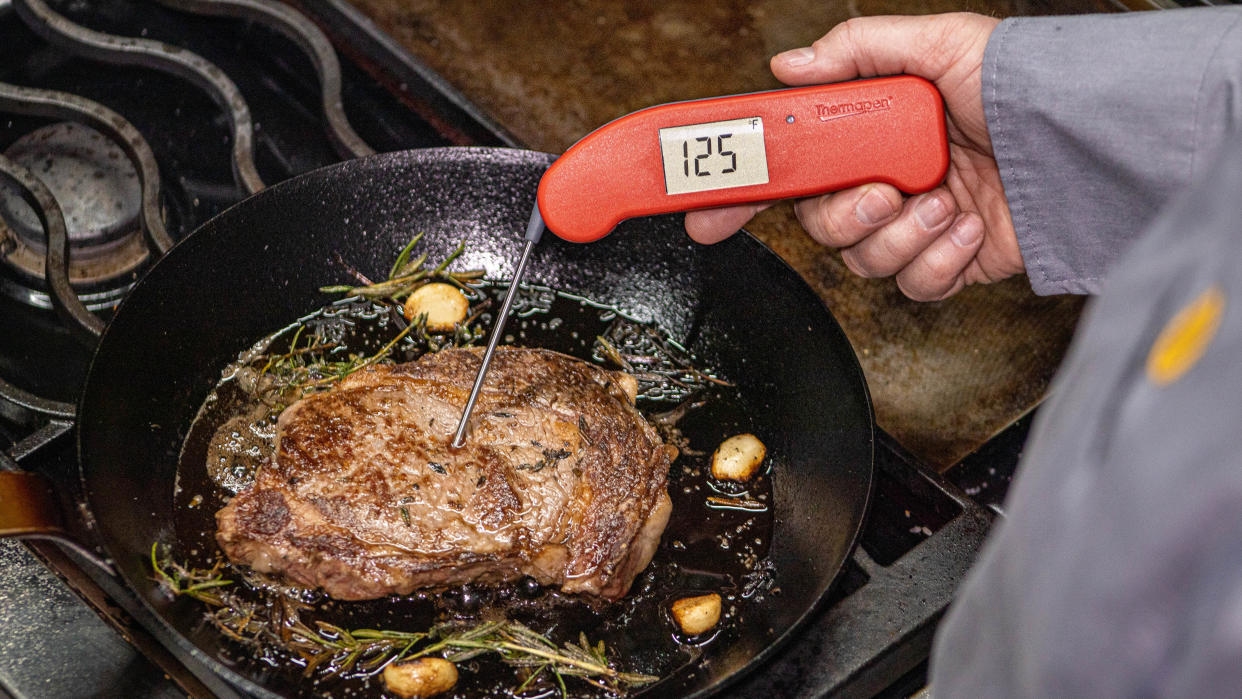
If you want to cook a steak to perfection, you’re going to need one of the best meat thermometers. Try as we might to master cooking meat, there’s always room for error — the cooking temperature as well as the size and type of meat all contribute to how long it needs on the heat. As a result, your joint is often over- or under-cooked, and we suffice. But, that doesn’t have to be the case with a meat thermometer. Using one of these, you can monitor the internal temperature of your meat and cook it to an exact degree. So however your guest wants their dish cooked, you can provide.
Modern meat thermometers can do much more than this as well. Some come with smart connectivity, so you can check the cooking progress from your phone. Others feature multiple probes, so you can cook several dishes at the same time. While all of this sounds impressive, don’t forget that accuracy, responsiveness and ease of use are the most important factors when it comes to picking out a meat thermometer. And that means you don’t necessarily have to spend top dollar to get a good performer. To find the best options out there, we tested a range of meat thermometers, considering everything from the settings on offer to the speed and accuracy of readings. These are the best meat thermometers.
What are the best meat thermometers?
ThermoWorks has been acclaimed for its kitchen thermometers for years, and when we put 12 popular models to the test, we instantly understood why: its thermometers were some of the best performers. The best overall meat thermometer for most people would be the new ThermoWorks Thermapen One, an instant-read model that truly lives up to the word “instant,” while also being nearly lab-accurate and loaded with more functionality than you might expect from such a small, simple device.
If you don’t want to pay quite so much, the ThermoWorks Thermopop is overall the best inexpensive choice: At just $35, it’s comparably accurate and foolproof, though you’ll have to sacrifice a little as far as convenience and speed.
For set-and-forget cooking, the ThermoWorks ChefAlarm Cooking Thermometer is a feature-rich leave-in model that works just as well in the oven or on the stovetop. Looking for a similar, less expensive version? You can do almost as much, almost as accurately, with the $24.99 Polder Classic Digital In-Oven Thermometer & Timer.
If you want more than just your medium rare steak to be bleeding-edge, the Yummly Smart Meat Thermometer connects to a mobile app for more options and more visual guides and data than you can get from any countertop model. It has some limitations, but it’s one of the most fun ways to cook — and our results were excellent.
The best meat thermometers for cooking you can buy today
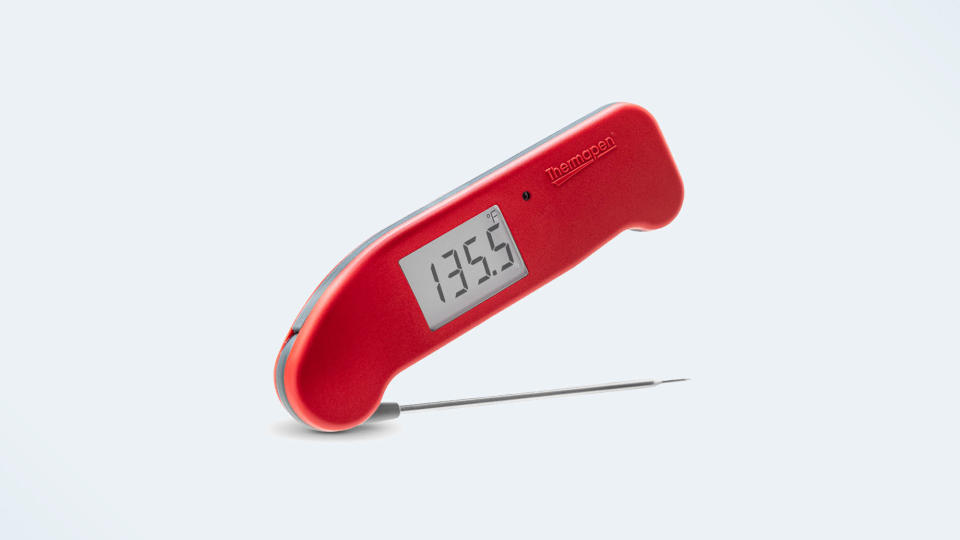

1. ThermoWorks Thermapen One
Best meat thermometer overall and best instant-read thermometer
Temperature range: -58–572° F | Claimed read time: 1 second | Tested read time: 1–1.5 seconds | Claimed accuracy: ±0.5° F | Tested accuracy: ±0.1° F | Usable probe length: 4.4 inches
Extremely fast and accurate
Wide array of useful features
Settings are easy to adjust
Pricey
There’s a reason the ThermoWorks Thermapen has become all but synonymous with instant-read thermometers among professionals and enterprising home cooks alike: it works exactly the way you think it should. You pull out the probe, it turns on, you take your reading, put the probe away, it turns off, and you’re done. It’s so intuitive, it may as well be an extension of your hand, and you can use it for anything from making candy on the stove to checking the doneness of a Thanksgiving turkey or loaf of bread.
The newest model, the Thermapen One, is the best yet. All the classic, top-notch features are here: a display that automatically rotates in four directions so the temperature is always face-up, a perfect size and ergonomic shape for large or small hands, a rubberized ring to aid in gripping, easy access to changing settings (whether you want Fahrenheit or Celsius, whether it should measure whole degrees or tenths) and the calibration tool. But now it’s even faster, giving you a solid reading in just over 1 second (upwards of three times faster than the previous, lightning-fast MK4). It also has a much brighter auto-on light and it’s been redesigned to work better with induction cooktops.
The Thermapen One aced all of our usability tests and was the most accurate model we looked at, routinely either matching or coming within one-tenth of a degree of our reference thermometer’s reading. Its only downside is its $105 price, which may not be within everyone’s budget. But if it’s within yours, this is a kitchen tool every bit as essential as a sharp knife, a dishtowel, and a sturdy oven mitt — it doesn’t just make your food better, it makes cooking a lot easier and more fun. That's why this product took home the Tom's Guide 2022 Award for Best meat thermometer.
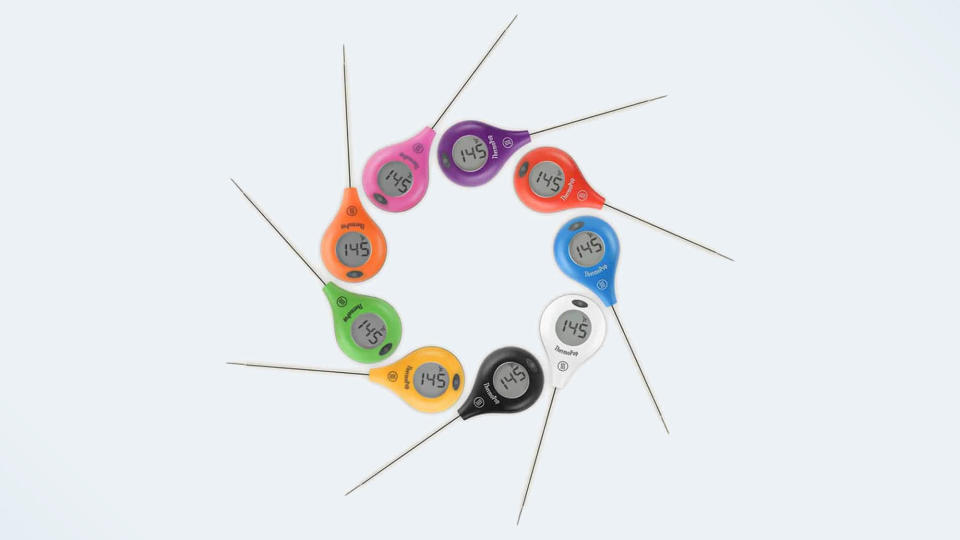
2. ThermoWorks Thermopop
The best budget instant-read meat thermometer
Temperature range: -58–572° F | Claimed read time: 3-4 seconds | Tested read time: 3-4 seconds | Claimed accuracy: ±2° F | Tested accuracy: Less than ±0.1° F | Usable probe length: 4.5 inches
Accurate temperature readings
Affordable
Attractive, useful design
Does not start or rotate automatically
Awkward button placement
If you can’t justify spending $105 on ThermoWorks’s top-of-the-line Thermapen One, $35 gets you a remarkably good substitute from the same company in the Thermopop.
Like its burlier, suaver big brother, it’s easy to use, accurate, and fast. You don’t get everything you do with the pricier model — you’re limited to full degrees, not tenths (ThermoWorks claims a ±2.0° F margin of error, though it always matched our reference thermometer in our heat tests); it takes a while to “boot” and 3 to 4 seconds to give you a static heat reading, but you get more than enough otherwise. Its user-friendly design and sensible controls will get you up and temping immediately.
We have minor complaints. You have to press a button to start the temperature reading or turn on the light. The display doesn’t rotate automatically; another button press is required. Some buttons are located on the front and some on the back. All the buttons are stiff and take more effort to press than it seems they should, and because the whole thing is a single, non-moving piece (not counting the included probe cover), you get less clearance while taking readings with the 4.5-inch probe.
Even considering those caveats, the Thermopop is a fine thermometer, ideally suited to anyone who’s getting started in the kitchen or doesn’t need (or care about) the bells and whistles that can add multiple Hamiltons or Jacksons to the price.
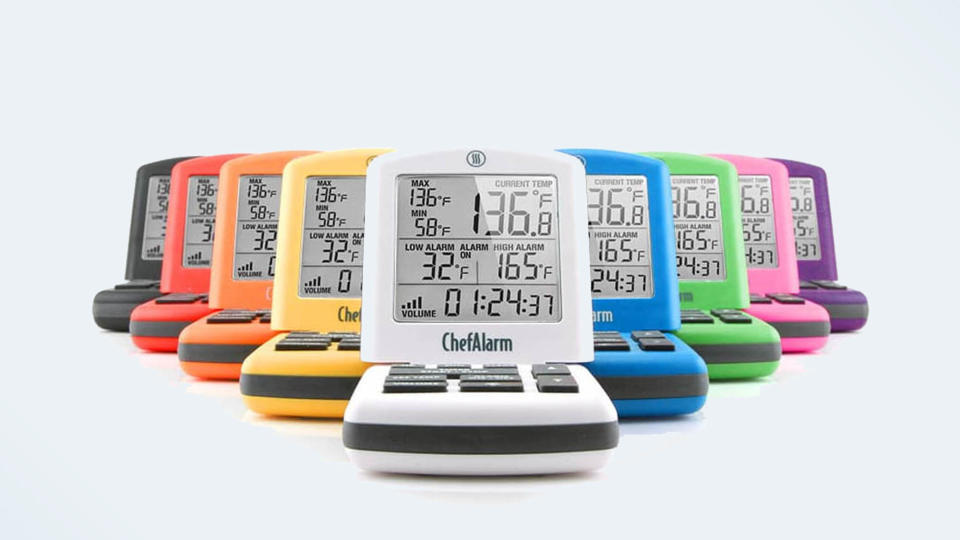
3. ThermoWorks ChefAlarm Cooking Thermometer
The best leave-in digital thermometer
Temperature range: -58–572° F | Claimed accuracy: ±1.8° F | Tested accuracy: ±0.5° F | Usable probe length: 6.5 inches | Probe cable length: 48 inches | Number of probes: 1
Incredibly easy to use
Lots of features
User calibratable
Pricey
Like its more ostentatious instant-read sibling, the Thermapen, the ThermoWorks ChefAlarm Cooking Thermometer does more, and does it better, than its leave-in thermometer competitors. If you don’t think you need anything to supplement your instant-read, the ChefAlarm may change your mind — especially if you roast a lot of big hunks of meat, deep fry, or make candy.
The 10 buttons on the ChefAlarm’s keypad are clearly labeled and arranged, so you’ll be setting your cook time, minimum and maximum temperatures, and alarms in seconds. But you can also adjust (or mute) the alarm volume or turn on a backlight that improves readability no matter how dark your cooking area. The wide Power switch is at the top rear of the unit, perhaps the most easily accessible place; below it are buttons for swapping the scale between Celsius and Fahrenheit and calibrating the thermometer, the latter a unique (but highly welcome) feature for this style. Two strong magnets on the back let you store the thermometer on your refrigerator or grill, just where you’re likely to need it most. And a handsome, zippered cloth carrying case is included for keeping the main unit, the probe, the clip, and the instructions all in one place.
The thermometer was also strongly accurate (within, at most, a half-degree) and consistent, whether spending hours in our “medium rare” water bath or just a few minutes in the volatile high heat of deep-frying peanut oil. The $65 price is admittedly a little steep, and maybe difficult to justify if you already have a good instant-read. But there’s not much else bad to say about the ThermoWorks ChefAlarm Cooking Thermometer.
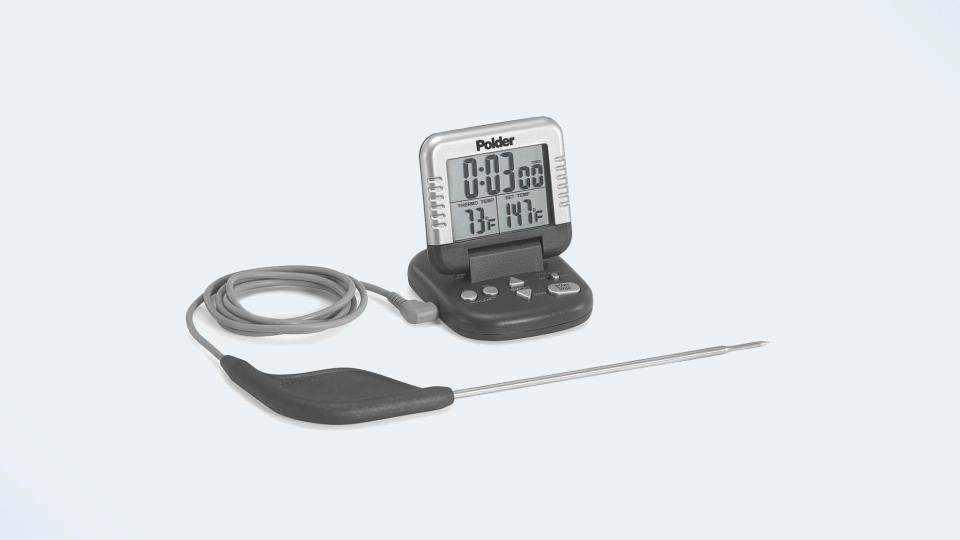
4. Polder Classic Digital In-Oven Thermometer & Timer
The best budget leave-in digital thermometer
Temperature range: 32–392° F | Claimed accuracy: N/A | Tested accuracy: ±1° F | Usable probe length: 4.4 inches | Probe cable length: 40 inches | Number of probes: 1
Low price
Easy to use
Small screen
Difficult to access on/off switch
We prefer external probe-style leave-in thermometers to their in-oven (and in-meat) cousins because they’re safer and significantly easier to read and program. This style of thermometer doesn’t get much easier than the Polder Classic Digital In-Oven Thermometer and Timer, a budget-friendly option that does all the basic stuff you need.
Setting your desired cooking time and temperature, or configuring the alarm to sound once your target temperature is reached, could not be easier. The alarm is piercing but clear and not unpleasant. And we noticed no problems with accuracy during our testing (though the thermometer measures only whole degrees, not tenths, so minute fluctuations were harder to detect).
Measuring less than 1.5 by 1.9 inches in area, the digital display is small, and the lack of a light can sometimes make it difficult to read. Though the bottom of the thermometer is a fine place to put the scale switch, as you’re unlikely to need to swap between Celsius and Fahrenheit very often, it’s a terrible location for the On-Off switch, which you’ll need every time you fire up the oven or grill.
All in all, the Polder Classic Digital In-Oven Thermometer & Timer doesn’t inspire many complaints, though aside from its attractively low price, it doesn’t inspire much excitement, either.
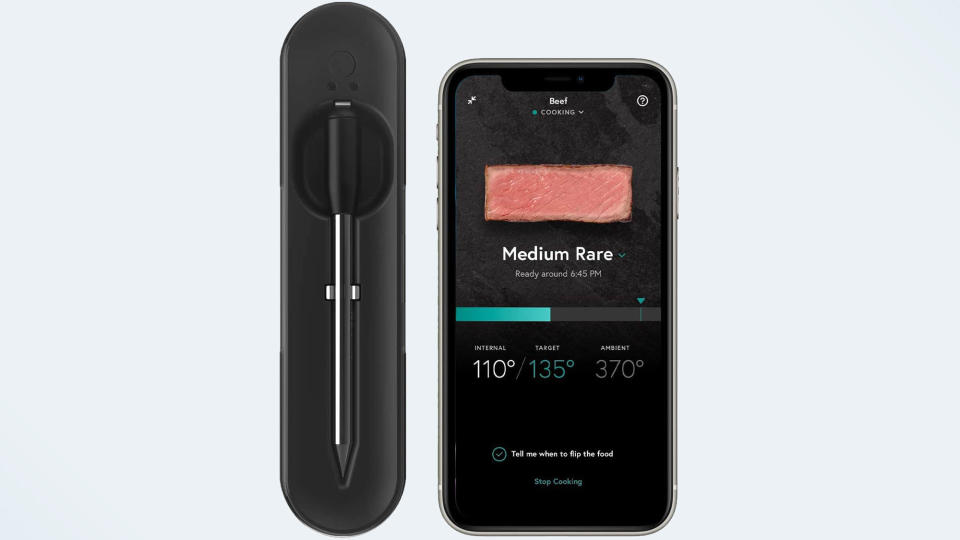
5. Yummly Smart Thermometer
The best smart meat thermometer
Temperature range: Up to 572° F | Claimed accuracy: N/A | Tested accuracy: N/A | Usable probe length: 3 inches | Probe cable length: N/A | Number of probes: 1 included (up to 4)
Excellent app experience
You can use up to four probes at once
Time consuming setup
Short probe
Although the Yummly Smart Thermometer ties into the (required) Yummly cooking app, which for a subscription fee gives you access to curated galleries of recipes matching your tastes and dietary requirements, you can also use it with any of your own recipes. Just fire up the gorgeously designed Android or iOS app, which is awash in sumptuous photos and sleek temperature graphics, follow the on-screen instructions, and wait until you receive the alarm and alert that your food is done.
Except it’s not quite that easy. Before you can use the thermometer, you have to set up a Yummly account, which is a tedious process involving selecting your preferred cuisines, ingredients, and so on. You then need to charge the thermometer on the battery-powered dock for 30 minutes and pair it with your phone or tablet, which took me a couple of tries to get right. Things weren’t even totally pain-free after that, as the app had trouble recognizing the paired thermometer for a few minutes when we were ready to use it. After that, though, things went swimmingly, and our roast eventually came out a stunning, mouth-watering medium rare. (The app even takes carryover cooking into account.)
But a single thermometer probe costs $99, which is pricey for something that only determines meat doneness, even via an app. If you want to cook up to four dishes this way at once, you can, but is that worth almost $400? The probe itself is among the smallest we saw, at just 3 inches of usable length, so larger chunks of meat or poultry might pose problems. And because the dock must remain no more than 5 feet away from the probe during cooking, you may have a lot of stuff to cart around to get it all to work.
The Yummly Smart Thermometer is dynamic and fun, no doubt, and a fine sign of what smart cooking is likely to resemble in the future. But, hopefully the ease of setting up will improve — and the price will come down.
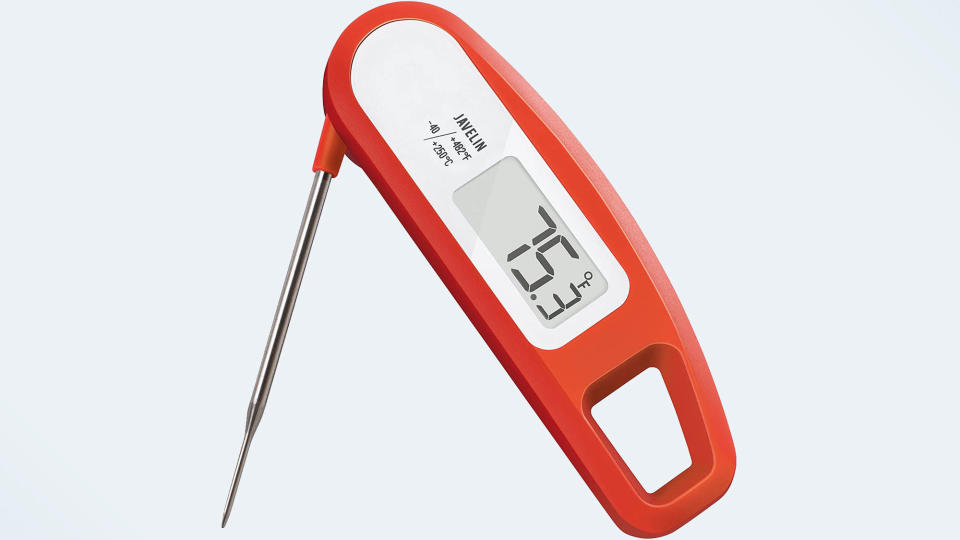
6. Lavatools Javelin
Best compact meat thermometer
Temperature range: -40–482° F | Claimed read time: 4-5 seconds | Tested read time: 4 seconds | Claimed accuracy: ±0.9° F | Tested accuracy: ±0.6° F | Usable probe length: 2.8 inches
Compact design
Magnetic storage option
Extremely short probe
Display does not rotate
The Lavatools Javelin isn’t quite small enough to attach to your keychain, but it’s close. Measuring just under 4.5 inches when closed, it’s far and away the shortest instant-read thermometer we tested. You won’t have to worry about it cluttering up your utility drawer, that’s for sure. (Although since it has integrated magnets, you can hang it up somewhere and not worry about its drawer presence at all.)
Although the Javelin’s size makes it easy to carry around, you have to take care to not cover the digital display with your hand, and because the probe measures just 2.8 inches, you’re going to have to get up close and personal with food you want to check — if you’re working in a deep pot or with a bulbous roast, it could prove both literally and figuratively painful.
The display doesn’t rotate or light up, two features that are much missed, but is to be expected at this budget price point. The thermometer is also powered by a 3-volt CR2032 battery, rather than one or two ultracommon AAA batteries, like every other model we looked at.
The Javelin is fast, with read times between 3 and 4 seconds, and although it’s not perfectly accurate, in our tests it was never off by more than 0.6° F, which should be fine for almost any home application. Affordable at just $26, the Javelin isn’t a bad buy, but it’s a reminder that, although good things frequently do come in small packages, in the kitchen it’s best to stay as far away from the heat as you can.
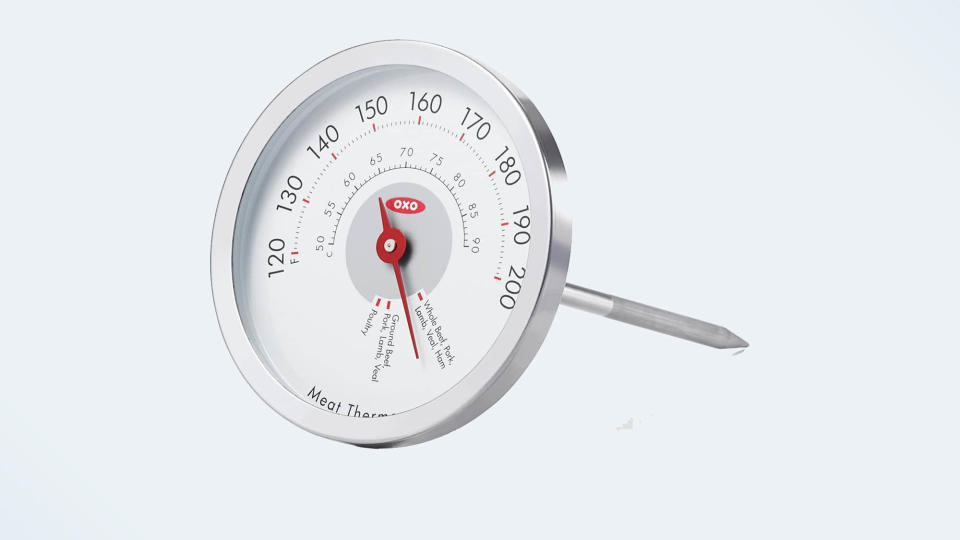
7. OXO Good Grips Chef’s Precision Leave-In Meat Thermometer
The best dial meat thermometer
Temperature range: 120-200° F | Claimed accuracy: N/A | Tested accuracy: N/A | Usable probe length: 2.2 inches
Very easy to read
Lots of guidance
Short probe not ideal for larger roasts
The OXO Good Grips Chef’s Precision Leave-In Meat Thermometer reminds me a lot of the kind of the meat thermometer my parents had while I was growing up — but it’s even easier to use and read. The textured bottom of the probe tells you exactly how far into the meat it needs to be inserted, and the 2.6-inch-diameter meter is easy to read, with temperature waypoints every 10 degrees between 120 and 200, markings in both Fahrenheit and Celsius, large type, and even a basic guide to safe cooking temperatures right on the dial. The slide-off probe cover contains the same numbers, plus explanations of the temperatures at which you can expect to hit medium rare, medium, and well done for a variety of different meats. As the product’s name suggests, OXO gives you a good grip on meat cooking.
The biggest problem we ran into while testing was the thermometer’s length. The instructions say to insert the thermometer to the edge of the textured area, but that’s only 2.2 inches in—not far enough to deal with big roasts. And because that leaves more than 3 inches of the thermometer sticking out above the meat, you may have trouble getting proper clearance in your oven. (We were able to do okay inserting it straight into the side, but it was a chore, and the probe didn’t want to stay in that position.)
Priced at just $16, the OXO Good Grips Chef’s Precision Leave-In Meat Thermometer is an inexpensive way to guarantee your meat is safely cooked to your desired level of doneness. Sure, it’s old-fashioned, but if meat is all you need it for, and you can negotiate into and out of your oven, it’s a fine thermometer my parents would have loved to have when I was a kid.
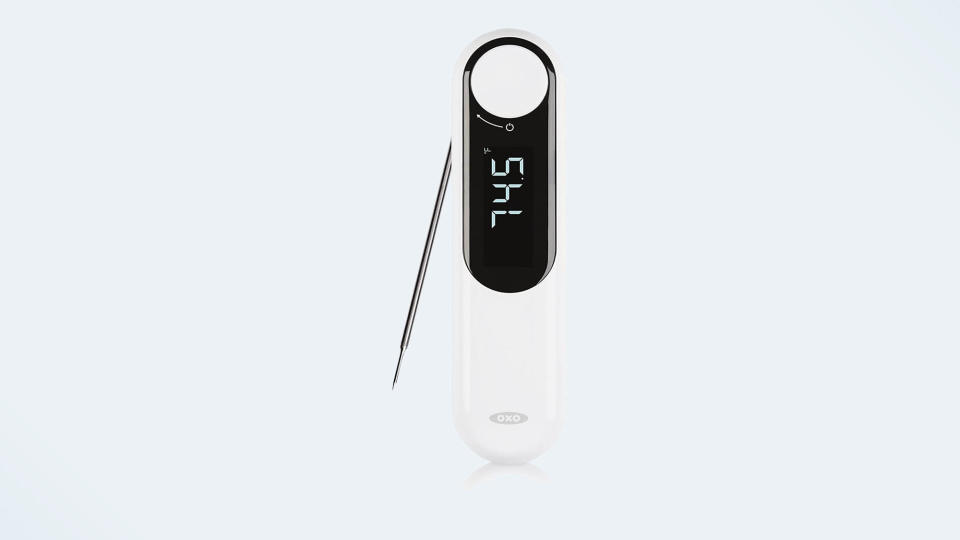
8. OXO Good Grips Chef’s Precision Thermocouple Thermometer
The most flexible meat thermometer
Temperature range: -58–572° F | Claimed read time: 2-3 seconds | Tested read time: 3-4 seconds | Claimed accuracy: ±0.9° F | Tested accuracy: ±0.6° F | Usable probe length: 4.1 inches
Easy to read display
Wide angle probe
Overly smooth body
Difficult to change settings
The OXO Good Grips Chef’s Precision Thermocouple Thermometer looks like exactly the instant-read thermometer you’d expect OXO to make. It’s big, stylish and black and white, with few obvious standout characteristics. Like so many of the other kitchen products in OXO’s all-consuming line, it’s quite a bit better than you may expect — if not perfect.
It’s long (just past 6.5 inches) and oval in shape, but also thick (0.8 inch) and with rounded edges, so it’s comfortable to hold. Its bidirectional rotating display uses white digits on a black background, which makes it easy to read in any amount of light. Most interestingly, the temperature probe rotates out to 225 degrees instead of the usual 180, so you can comfortably take temperature readings in any position, using your dominant hand, no matter which it is. Even the ThermoWorks Thermapen doesn’t do this.
Though fast, it’s not the most accurate of the thermometers we tested, as it was routinely off by about a half-degree. Its bigger hurdles relate to usability. The shiny body is overly slick, the integrated knob for opening the probe is harder to use than just pulling it out by the metal and if you want to change either the scale or the temperature resolution, you have to move two inset switches in the bottom of the battery case. This was an unusually difficult process we couldn’t accomplish with the recommended Phillips screwdriver (we needed a toothpick).
Maybe the most unfortunate drawback of the OXO Good Grips Chef’s Precision Thermocouple Thermometer is its price. If it were less expensive, it would be a more compelling buy, but listing for $104, just barely below the notably superior Thermapen One, it doesn’t compare. Our recommendation: root through your couch cushions, find that extra penny, and get the Thermapen One instead.
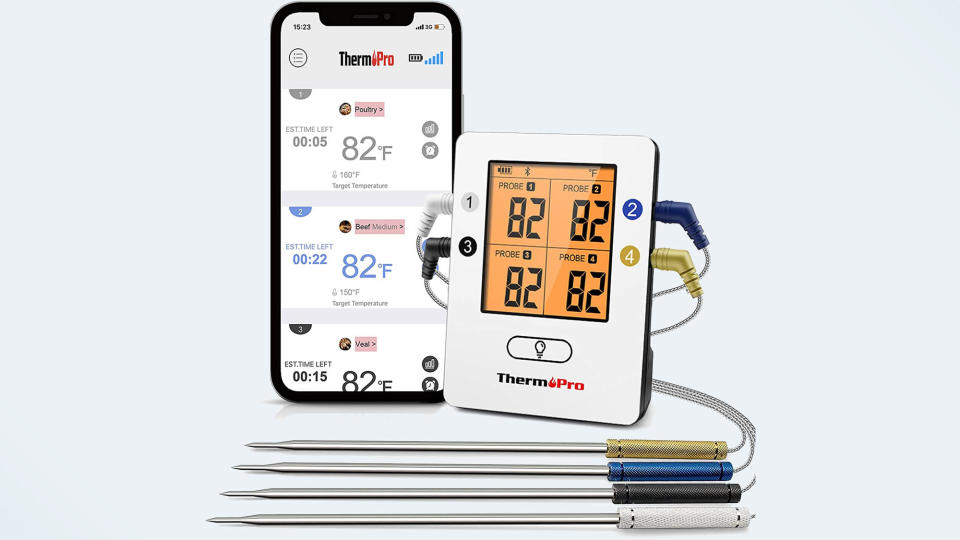
9. ThermoPro TP25 4 Probe Bluetooth Remote Meat Thermometer
For when one meat thermometer isn't enough
Temperature range: 32-572° F | Claimed accuracy: ±1.8° F | Tested accuracy: ±1.5° F | Usable probe length: 6 inches | Probe cable length: 42 inches | Number of probes: 4
Allows cooking of multiple dishes at once
Potential accuracy issues
Unpolished app
Questionable temperature guide
If you frequently cook for big or picky groups, a single meat thermometer might not be enough. The ThermoPro TP25 4 Probe Bluetooth Remote Meat Thermometer offers all the convenience of a digital leave-in thermometer but is equipped with four different probes that feed the main unit (and the accompanying, required app). Being able to manage multiple pieces of meat, while also juggling different cooking times and temperatures (this group likes their beef medium rare, that group is having roast chicken, and so on), gives you more flexibility in the kitchen or at the grill than most other models we’ve covered.
This does present its own challenges, as arranging all four probes (two plug in to each side of the base unit) at the same time is cumbersome, and your cooking setup may not allow for an easy solution. There are other, more confidence-sapping issues, too. The product box is riddled with typos. The app is intuitive but poorly designed and irritating to navigate, like a half-finished prototype that somehow snuck out the door. I also question its built-in temperature presets, which define medium rare for beef at a too-high 140° F, and indeed, our roast cooked at this preset came out firmly medium. Although you can create your own presets for the desired target temperature or range, you can’t edit any of the default ones, no matter how silly you find them (ground beef has to be 160° and poultry 165°? Really?). Most annoying of all: the thermometer had been consistent and mostly accurate during the first two and a half hours of the water bath test, but its battery ran out at that point and the thermometer had to be plugged in, resulting in its temperature readings fluctuating wildly across an unacceptable range of more than 20 degrees.
The combination of the four-way functionality and the reasonable price of the ThermoPro TP25 4 Probe Bluetooth Remote Meat Thermometer may make it a passable investment if you’re a big-time grill master or party thrower. Just remember that the extra time you’ll need to spend untangling cables and getting everything perfect in the app is time you could instead be spending with your guests — and don’t ever let the battery run out while you’re cooking.
What to look for in a meat thermometer
Style
There are a number of different types of thermometer on the market, and what you like to cook will be the primary decider for which style you buy. If you rarely cook anything more than roast beef or chicken, a simple, leave-in meat thermometer may do the job (and, in most circumstances, will be highly affordable). You can up your game with a digital remote probe-style thermometer, which thanks to cabled probes lets you see the meat’s current temperature from outside the oven, set temperature maximums and alarms, and more. These are also good for deep frying or sugar work, if you have a model that clips on to the side of the pan. If you’d prefer a single, go-everywhere model, an instant-read can work in all these places, though these make it more difficult to chart temperatures over time.Analog or digital
Analog thermometers are typically less expensive than digital, but they’re also invariably slower and usually more difficult to read. This matters less with a thermometer you’re going to leave in the Thanksgiving turkey for a few hours than it does with a thin steak or caramel sauce, where every change in degree can spell the difference between success and failure. As some good digital thermometers are available for $35 or less, you’re better off getting one of those if you can.Instant-read features
The most important features for instant-read thermometers are the size and design: you want one that isn’t too small or too big, that has an easy-to-access probe, and that you can firmly grip even if steam or grease interfere. Many newer instant-read models also have displays that light up or rotate in two or four directions (so you can see the temperature no matter where you or the food are located); these are helpful, but may add a lot to the final price.Number of probes
Most remote probe-style thermometers only include one probe, so you can only track the temperature of a single dish at a time. Some, however, include up to four probes, letting you prepare wildly different recipes with just a single device. This is handy, particularly if you entertain a lot or frequently prepare multiple meats at once, but can also be logistically difficult (as you may have a lot of probes and cables to organize) or expensive (for models where each probe is sold separately).Resolution, scale, and calibration
Home thermometers measure in either whole degrees or tenths of a degree; make sure you know how much detail you want, as not every thermometer does both — and those that do should make it easy to switch between the resolutions. Similarly, the thermometer should display the temperature in both degrees Fahrenheit or degrees Celsius, so you can use it no matter where you live, and allow you to easily flip between the two. Though it’s not a necessity, calibration is an excellent additional feature; by measuring a known temperature (such as ice water) and adjusting the readout accordingly, you can continue using your thermometer even if its initial accuracy diminishes over time.Smart functionality
Smart thermometers can connect with a mobile app so you can follow what’s happening in the oven even when you’re away from the kitchen. This is still something of a gimmick, and is of limited utility unless you’re making a long-cooking dish that might suck up most of your day. But, apps that allow long-term temperature tracking and have presets for certain kinds or cuts of meat may help take some of the guesswork out of the process. Use one that’s customizable, though, as your cooking equipment and personal preferences can be difficult to hard-code into any software.
How much should you pay for a meat thermometer
The price of a meat thermometer can range from less than $10 to over $100. Naturally, the more you spend, the more features you’re going to get, such as app connectivity and additional probes. However, that’s not to say you can’t get a good meat thermometer for a good price.
Decide on your budget as well as what you need before browsing for a new thermometer. Consider what you will use it for and whether the extra features would prove useful. If you want one from a premium brand, such as ThermoWorks, be prepared to pay a premium price. However, even ThermoWorks offer options for those on a budget, such as the ThermoPop, so be sure to do your research before you invest.
How we tested kitchen thermometers
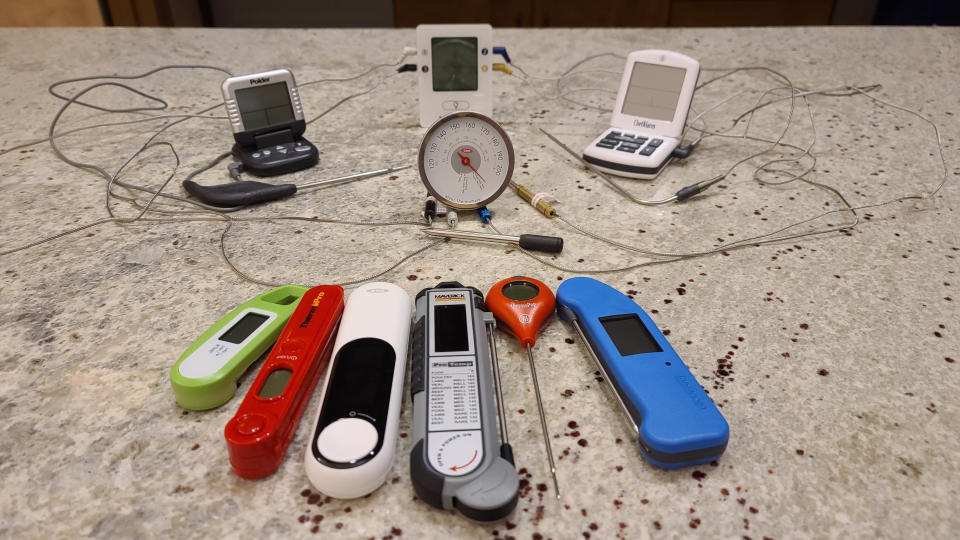
To assess the 12 kitchen thermometers, we put them through a series of objective and usability tests that would allow us to determine their overall technical capabilities and how well they worked in everyday kitchen tasks.
To measure speed and accuracy of instant-read thermometers, we set up water baths at three different temperatures: one filled with ice water at just barely over 32° Fahrenheit, one with water kept at a constant temperature (approximately 125°, or where you’d expect to pull a piece of beef for medium rare doneness) via a sous vide machine, and a pot of water boiling at just over 204° (the boiling point affected by the altitude of our test space). We dipped each thermometer’s probe in the water, timed how long it took the temperature reading to stabilize, and compared its temperature reading with one from a freshly calibrated, lab-quality reference thermometer.
For digital remote-style probe thermometers with cables, we used the 125° water bath and the reference thermometer to track temperature consistency over a period of 5 hours.
We then enlisted the thermometers for an all-day cooking marathon, roasting four-pound slabs of top sirloin until they reached medium rare. For instant-read and clip-on thermometers, we also deep-fried French fries and tortilla chips, in each case using multiple units to compare accuracy and usability. Along the way, we tried as many of the thermometers’ special features (such as temperature alarms or mobile apps) as possible, so we could mimic how they would function in the real world.
Once we were finished cooking, we also went through the process of cleaning and storing them, to see how well they could withstand those everyday maintenance.

